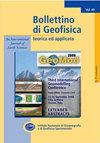Controlled laboratory test for the investigation of LNAPL contamination using a 2.0 GHz ground penetrating radar
IF 0.7
4区 地球科学
Q4 GEOCHEMISTRY & GEOPHYSICS
引用次数: 4
Abstract
Groundwater is an important source of fresh water and, consequently, its quality should be properly monitored. Different contaminants can be identified with different types of equipment and/or measurement procedures. Fuel oil contamination forms a “floating” layer over the water table, which has different electrical properties, therefore electromagnetic techniques can be used to image such contaminants. This paper presents a scale-laboratory test where a 2.0 GHz ground penetrating radar (GPR) is used to assess a controlled-fuel oil injection in a shallow sand tank setup. The test examined several scenarios involving different levels of water saturation and fuel oil contamination. The increase of water content produces a reduction of EM wave propagation velocity, moving some fixed/reference targets to higher reflection times. We use simplified relations to obtain approximated dielectric permittivity values, where the inverted results are consistent with those available in the literature for similar scenarios. Rather than suggesting a true quantitative procedure, these observations could be exploited in a qualitative long-term monitoring strategy in common field situations where a contaminant enters a soil matrix and moves through its pore spaces. Finally, the integration of GPR measurements with other monitoring techniques could increase the reliability of the interpretation and the sensitivity to the contaminant concentration.使用2.0 GHz探地雷达进行LNAPL污染调查的受控实验室测试
地下水是淡水的重要来源,因此应适当监测其质量。不同类型的设备和/或测量程序可以识别不同的污染物。燃料油污染在地下水位上形成一层“浮动”层,具有不同的电学特性,因此可以使用电磁技术对这种污染物进行成像。本文采用2.0 GHz探地雷达(GPR)对浅层砂罐控制燃油喷射进行了实验室规模试验。测试测试了几种情况,包括不同程度的水饱和度和燃油污染。水含量的增加会降低电磁波的传播速度,使一些固定/参考目标的反射时间增加。我们使用简化的关系来获得近似的介电常数值,其中倒置的结果与文献中类似场景的结果一致。这些观察结果不是建议一个真正的定量程序,而是可以在污染物进入土壤基质并通过其孔隙空间移动的常见现场情况下,在定性长期监测策略中加以利用。最后,探地雷达测量与其他监测技术的结合可以提高解释的可靠性和对污染物浓度的敏感性。
本文章由计算机程序翻译,如有差异,请以英文原文为准。
求助全文
约1分钟内获得全文
求助全文
来源期刊

Bollettino Di Geofisica Teorica Ed Applicata
地学-地球化学与地球物理
自引率
0.00%
发文量
0
审稿时长
>12 weeks
期刊介绍:
The "Bollettino di Geofisica Teorica ed Applicata" is an international open access journal dedicated to the publication of original papers dealing with Deep Earth Geophysics, Near Surface Geophysics, Exploration Geophysics, Borehole Geophysics, Geodynamics and Seismotectonics, Seismology, Engineering Seismology, Geophysical Modelling, Geodesy, Remote Sensing, Seismic and Geodetic Networks, Oceanography, and their application in the fields of Energy, Natural Resources, Environment and Climate, Policies and Regulations, Risk and Security, Technological Development.
 求助内容:
求助内容: 应助结果提醒方式:
应助结果提醒方式:


